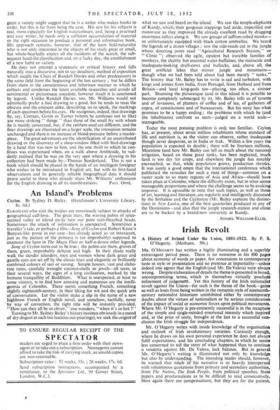An Island's Problems
EUROPEANS who visit the tropics are notoriously subject to attacks of geographical calf-love. The great stars, the waving palms of spice- scented valley or island easily turn our poor rain-bleached heads. Sometimes the attack of infatuation is unexpected. Sometimes a traveller's tale, or perhaps a film—Song of Ceylon and Robert Knox's Bunyan-like prose in our case—has already acted as an intoxicant, just as the picture of the princess is (so improbably) supposed to enamour the hero in The Magic Flute or half-a-dozen other legends.
Song of Ceylon turns out to be true ; the palms are there, groves of them, green, improbably delicate and high. In their shade really walk the slender islanders, men and women whose dark grace and gazelle eyes are set off by the classic lines and elegantly or brilliantly combined colours of sari or sarong. Simple houses, vast and elabo- rate ruins, carefully wrought coconut-shells or jewels—all seem, in their several ways, the signs of a long civilisation, marked by the humane tranquillity of Buddhism. What is unexpected, at least to some visitors, is to find how amusing and numerous are the intelli- gentsia of Colombo. There seems something French, something slightly eighteenth-century, in their liking for wit and the quick arts of conversation. Let the visitor make a slip in the name of a new highbrow French or English novel, and somehow, tactfully, never ' by way of correction, the right title will be instantly provided. "How can they all be so clever," one wonders, "when it's so hot ?"
Turning to Mr. Sydney Bailey's history (written obviously in a mood of dry disgust at such too luscious out-pourings), we seek the origintof what we saw and heard on the island. We saw the temple-elephants of Kandy, which, their gorgeous trappings laid aside, imperilled our motor-car as they improved the already excellent road by dragging enormous rollers along it. We saw groups of saffron-robed monks— so unfortunately equipped with black cotton umbrellas. We heard the legends of a dozen villages ; saw the side-roads cut in the jungle whose directing posts read "Agricultural Research Station," or " Clinic "; observed the agile, opulent but irascible families of monkeys, the shabby but essential water-buffaloes, the miniscule and inadequate-looking draft-cows and bullocks, and, above all, the great artificial lakes that mirror jungle and mountains— though what we had been told about had been merely "tanks." The history that Mr. Bailey has to write is sad and turbulent, with kings and armies from India, from Portugal, from Holland and from Britain—and local king-gods too—playing, too often, a sinister part. Shunning the picturesque (and in this island it is possible to become completely submerged by it), Mr. Bailey tells us of tyrants and of invasions, of planters of coffee and of tea, of gatherers of copra, of constitutions and of bureaucrats. But his story has what promises to be a happy ending ; the problems with which he (and the inhabitants) confront us seem—judged on a world scale— manageable.
Today the most pressing problem is only too familiar. Ceylon has, at present, about seven million inhabitants whose standard of life and nutrition is, as the visitor can observe, rather inadequate though never desperate, as in India or Irak. Within a few years the population is expected to double ; there will be fourteen millions. Meantime (and here Mr. Bailey can tell us much about the reasons) irrigation, based on those great tanks, has been neglected, much land is too dry for crops, and elsewhere the jungle has notably encroached, so that, while population grows, production shrinks. It was surely a good omen that the international conference which publicised the remedies for such a state of things—common on a vaster scale to so many regions of Asia and Africa—should have taken place at Colombo, where the difficulty exists, but in what seems manageable proportions and where the challenge seems to be evoking response. It is agreeable to note that such topics, as well as those of art, learning and literature, are regularly and intelligently discussed by the Sinhalese and the Ceylonese (Mr. Bailey explains the distinc- tion) in New Lanka, one of the best quarterlies produced in any of the Dominions—and also that the jungle research-station and .clinic are to be backed by a brand-new university at Kandy.
AMABEL WILLIAMS-ELLIS.


































 Previous page
Previous page